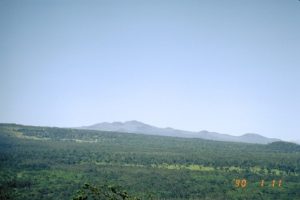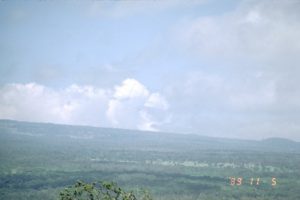REGIONAL HAZE
What is Regional Haze?
Regional Haze causes visibility impairment over a large region primarily from sources that emit fine particulate. Fine particulate that absorb and scatter light to cause the haze can be directly emitted into the air or formed from gases. The sources of this particulate can be human-caused (anthropogenic) or from natural events. Natural sources of particulate in Hawaii include aerosolized salts from sea spray or sulfur dioxide (SO2) from volcanic activity. For example, the Kilauea Volcano creates vog (volcanic smog) when SO2 reacts with sunlight and constituents in the air to form sulfates that have caused haze on the island of Hawaii and on other islands hundreds of miles away. Other natural sources include soot from wild fires and windblown dust. Anthropogenic sources of particulate include electric plants, industrial fuel burning facilities, motor vehicles, construction activities, and agricultural burning.
Photo on day with visual range of about 200 miles compared to a severe vog day and an extremely severe vog day on the island of Hawaii. Vista reference is Mauna Kea on the island of Hawaii (Big Island).
Federal Regional Haze Rule
The U.S. Environmental Protection Agency (EPA) issued the Regional Haze Rule on July 1, 1999 to establish goals and emission control strategies to protect visibility in 156 Class I areas (Map) from anthropogenic air pollution. The goal of the rule is to restore natural visibility conditions in these Class I areas by 2064. Another objective of the rule is to improve the visibility on the most impaired days at each Class I Area, and to protect the visibility in these areas on the clearest days. Hawaii’s two (2) Class I areas, managed by the National Park Service, are:
- Haleakala National Park on the island of Maui
- Hawaii Volcanoes National Park on the island of Hawaii (Big Island)
Federal Regional Haze Rule Update
The Regional Haze Rule, 40 CFR Part 51, Subpart P – Protection of Visibility, updated in 2017, requires states to periodically submit Regional Haze State Implementation Plans (RH-SIPs) every ten (10) years. These plans provide long-term strategies for reducing emissions that impair visibility and must demonstrate how progress will continue to be made in achieving visibility improvement goals. The first state plans were due in 2007 and covered the 2008 -2018 planning period. Since Hawaii was unable to submit a RH-SIP for the first planning period, the EPA developed a Regional Haze Federal Implementation Plan (RH-FIP) that was promulgated on October 9, 2012.
For the second 2018-2028 planning period, the due date for submitting the RH-SIP was extended from July 31, 2018 to July 31, 2021. On April 7, 2022, EPA announced its intent to make Findings of Failure to Submit for states that failed to submit their RH-SIP for the second planning period. States wishing to avoid inclusion in the Findings of Failure to Submit were compelled to submit their second planning period RH-SIP by the August 15, 2022, deadline. [Source: https://www.epa.gov/visibility#:~:text=The%20EPA%20intends%20to%20issue]
The Regional Haze Rule also requires states to submit five (5) year progress reports describing progress towards achieving the visibility goals for each Class I area. Hawaii’s first progress report was due five (5) years from submittal of the RH-FIP. Subsequent progress reports are due by January 31, 2025, July 31, 2033, and every ten (10) years thereafter.
Regional Haze Planning Period 1:
- 2012 Technical Support Document for RH-FIP
- 2012 RH-FIP
- 2017 Progress Report
- 2017 Progress Report Support Documents
Regional Haze Planning Period 2:


